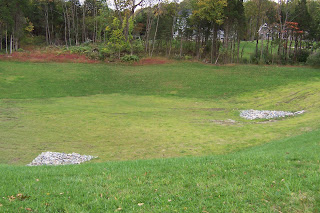Gardening as Process: Planning and Mapping –2

Once you’ve defined your activity areas, it’s time to take inventory of the plants you already have. At one extreme, a relatively new house will have next to nothing. At the other, your house, like mine, may be in the middle of the woods.
On an open lot, you’ll probably want to plot every tree, large or small. In a mature garden, scalloped-edged bubbles can indicate a stand of deciduous trees; spikey-edged bubbles, an evergreen stand. If you have only a few young trees, you’ll need to imagine what they’ll look like when fully grown, for example into a 90-foot tall, three-foot diameter oak, with a canopy 50 feet wide. Your landscape map should indicate the mature size of your plants.
Next, it’s time to edit. If you have a small city lot, take out that oak now, while you still can and replace it with a tree that’s more in keeping with the scale of your garden, a service tree (Amelanchier) for example. Other readily available choices are ornamental cherry (Prunus), flowering dogwood (Cornus), or crabapple (Malus). Today, plant breeders have developed dwarf or miniature versions of nearly everything so, if you have your heart set on a particular type of tree, keep looking until you find the right size.
I can’t overemphasize the importance of choosing the right trees for your garden from the beginning. They’re expensive, they take a long time to grow, and if you have to take one out later, that’s even more expensive. Between the tree-cutters, their equipment, and the new sunspot opened up by removing the tree, the other plants in your garden are likely to go into shock, as well.
If the trees in your garden have grown up over the years, you may want to try viewing everything with a new eye. If you were starting from scratch, would you still want what you have? Are some of the trees in decline? Shading out too much of the flowerbed? A tree doesn’t necessarily have to be removed. High limbing can do wonders for a garden. It preserves desirable shade and air cooling properties, but lets in enough sunlight for most perennials to thrive.
Repeat this process for your shrubs and perennials. Your layout sketch should portray a birds-eye view snapshot-in-time of the current state of your garden.

